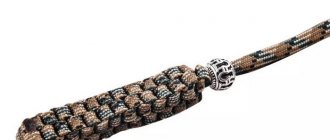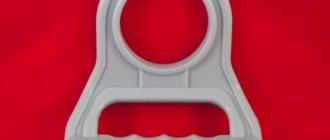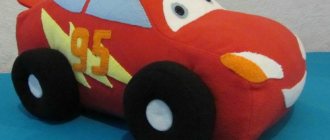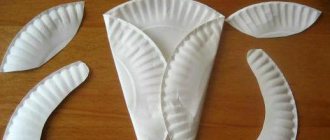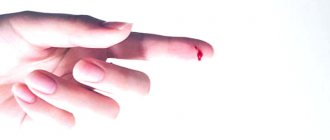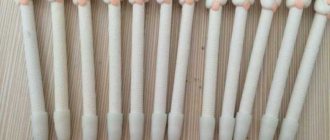An antler knife handle is an exclusive product that can be made from material from elk, deer, saiga, and roe deer. The horn requires preliminary processing: it needs to be boiled, cored, polished, and sometimes heated in a special oven. But such difficulties are inherent in working with fresh, unsettled horns; in all other cases, the master’s algorithm of actions is quite simple.
You can make horse-mounted handles, attachment-type handles, and set handles from horns, but overhead ones will present difficulties - you will need to cut the material strictly along and without cracking the surface. Horns are a “grateful” material, because if properly processed they will last a long time, they do not absorb moisture and odors, do not slip in the hand and can be decorated with artistic miniatures, pieces of genuine leather and wood.
Advantages of a knife handle made of horn
Horn knife handles have clear advantages:
- have a pleasant structure to the touch;
- the material always maintains the optimal temperature, regardless of whether it is hot outside or frosty;
- does not slip from moisture, even if it is the blood of a killed/butchered animal;
- The surface of the horn has a beautiful texture.
To fully experience and appreciate the advantages of a knife with a horn handle, you need to be able to make the right choice of source material. And it is important to consider the following nuances:
- whether the animal shed its horns itself or “lost” them forcibly - in the first case, the material will have a loose and spongy structure;
- what part of the horn fell into the hands of the master - experts say that only the upper part of the original material should be used to make a knife handle (the structure will be as dense as possible);
- age of the animal - if the horns were shed when they were young, they will not have sufficient strength, but will actively absorb moisture.
Masters of making knife handles from horns and users of such weapons have compiled a kind of rating of the source material in ascending order:
- cow, goat horns;
- shed deer;
- cut down deer;
- shed elk;
- hunted elk antler (cut from a killed animal);
- walrus tusk.
The worst option is cow and goat horns, which have weak strength and high porosity. Of course, this material can be used to make a knife handle, but it will have to be pre-treated with special moisture-retaining agents.
We recommend reading the article about knife handle options. From it you will learn about the characteristics and properties of knife handles, types of fastening, and options for making handles from different materials. And here is more information about the characteristics of the pchak knife.
What horns are used for the handle?
To obtain a reliable handle, you need to have an idea of the qualities of the “headgear” of various animals. The structure of the horn will definitely tell you about the age and type of the quadruped. It is of considerable importance how the product for the handle fell into the hands of the master.
Did the beast throw them off himself? Killed by a hunter or predator. There are many cases of illness and then death of a mammal. All these factors affect the quality of the future handle. For clarity, the beast itself dropped them, they will have a loose and spongy state.
Obviously not a very suitable option, using such horns the result will be a handle that absorbs moisture and dust. It will be necessary to produce additional coverage. Experienced craftsmen have compiled a unique rating of the quality and strength of the horns of some animals:
- Walrus tusk.
- An elk horn obtained by a hunter.
- Dropped by a moose.
- Cut down deer.
- Discarded deer.
- Cow, goat and others.
The rating corresponds to the numbering. The upper part of the horns is used for the handle; they are older and denser.
Advantages of a horn handle
This attribute of the head of the beast grows constantly throughout life. It is used to protect against attacks from predators, in the fight for a female with similar individuals. They are usually reset after a period of copulation. It has a bone structure and a lot of advantages when making a handle:
- thermal tolerance to frost and heat;
- there is no slipping when wet;
- the texture resembles anatomical in shape and touch;
- aesthetic beauty.
Definitely, these positive results can be achieved with the right choice of material. Not all horns have these qualities.
Knife handle made of elk horn
Moose antler is valuable in all parts. Masters value the branched part, and find full use for it. A sawn-off small horn is preferable when making small blades. It has good hardness and is used in the form of a mounted method.
Knives with handles made from elk horn.
The middle part of the horn, the scapula, is no less valuable. Having sawed it lengthwise into two halves, they use it as overhead handles. Beautiful, convenient and reliable.
Knife handle made of deer antler
Deer antler can be easily processed, applied with artistic miniatures and painted. It is also used for sheaths. Any animal horns should be aged, otherwise they are subject to temporary deformation. Deer are no exception. They consist of periosteum, bone and spongy part from the inside.
When processing the product, beware of fine dust; use a respirator. The smell when grinding is unpleasant. The best material is considered to be deer antler - sambar, originally from India. Poachers destroyed many animals in pursuit of goods.
A knife with a handle made of deer antler.
Eastern European animals have more valuable material on their heads than those from Central and Western Europe. By feeding animals with minerals, bone tissue acquires the necessary qualities.
What is good about a knife handle made from elk horn?
Elk antlers are distinguished by the fact that all their parts can be “used”; experienced craftsmen make their choice in favor of the branched part of the entire elk “structure”. Even if a small horn is sawed off, it will be possible to make a handle for a small knife from it, which will have high strength and an aesthetic appearance.
Small-sized elk horns are used to make handles that are mounted on the blade using the mounted method.
The middle part of the horn, the so-called “scapula,” is also considered valuable. It is sawn lengthwise into two halves and used to make overhead handles - reliable, convenient and quite beautiful.
From deer horn
Not only handles, but also sheaths are made from deer antler, because such material can be easily processed, painted, various decor can be applied to it, and even artistic miniatures can be created. Deer antlers consist of periosteum, bone and spongy tissue, and therefore they must be aged - if this period is ignored, then deformation of the product is inevitable.
The best deer antlers are those that are removed/dropped from sambar - this type of animal is found only in India. But experts prefer to use in their work the antlers of deer living in Eastern Europe - in nature reserves, these animals are regularly fed with minerals and vitamins, which makes the material for the handles especially durable and hard.
The natural lines especially located on the surface of the horn make it convenient to use the knife with the right hand - the handle fits perfectly into the palm. During grinding, a cloud of dust rises into the air, so you only need to work with deer antlers while wearing a respirator.
Are they made from roe deer horns?
Knife handles are made from roe deer horn, but there are several nuances in the process that need to be taken into account:
- You only need to grind the horn by hand and with slow movements - this will prevent the pores from opening;
- if pores do open on the surface of the material, then they are filled/mask with epoxy resin;
- try not to overheat the material, because at too high temperatures it becomes brittle.
Vintage guillotine knife for cigars with roe deer horn
Roe deer horns look great under a varnish coating - every natural line is “drawn”, and when polishing the product you can achieve its pearlescent shine.
Experts do not make handles from goat and cow horns, but this material is suitable for beginners to gain experience and understand the essence of the process. The only thing that professionals risk getting involved with is the horns of mountain goats or rams, which have:
- sufficient strength of the top layer;
- bizarre shape;
- soft/porous/spongy core.
They cannot be straightened even when heated in a muffle furnace (they break and become very brittle), but they are very easy to make hollow and use as a horse-mounted handle. The surface of the horns of mountain goats and rams “wears” the varnish coating well.
How to make a handle for a knife from horn with your own hands
To make a handle for a knife from horn with your own hands, you must first master the technology of processing the source material:
- The horns are cleaned of stubborn dirt and dust. The grooves on the surface of the material can be easily cleaned using thin wooden sticks, a brush (you can use a toothbrush) and turpentine. All treatment areas must be dried by blotting with a textile napkin.
- If the horns are not laid down and have an immature core inside, then it needs to be removed - this can be done with a narrow spatula, a narrow knife and any other suitable/convenient tool.
- Boil the prepared horn in a lime solution. To prepare it, place 0.5 kg of slaked lime on a bucket of water and heat it to a low boil (“on the boil”). It takes 2-3 hours to cook the horn in this mode. This stage is necessary to stiffen the “fresh” antlers. If you use already rested material as a trophy, then there is no need to boil them in a lime solution.
After all stages, the horns are polished, cleared of the top layer and used for their intended purpose.
There is another option for preparing horns for work, which is considered quite extravagant - mummification . The essence of the method is to mix equal amounts of kitchen salt and washing soda, clean the workpiece from the internal contents and place it in the prepared dry mixture for 2 months in a warm place. If everything is done correctly and fresh material is used, the result will be a flawless knife handle blank.
The ideal combination for work, which does not require specific preparation of the material, is horns shed independently and rested for at least 12 months.
Materials
The set of materials that will be needed to make a knife handle from horn is practically no different from that required for working with wood:
- impregnating oil;
- epoxy adhesive;
- clamps;
- a simple pencil for marking;
- grinding machine;
- a piece of genuine leather, the horn itself and a small block of wood;
- hacksaw for metal and wood;
- drill with a full set of drills.
Impregnating oil Epoxy glue Hacksaw for metal and wood Grinding machine Carpenter's clamp Deer antlers
This set is needed for making a mounted mounted handle - its installation is quite complicated, but the product looks impeccable.
How to do it yourself
If a stacked handle is made from horse-drawn horn, then the operating algorithm will be as follows:
- The prepared horn is cut crosswise into bars of different sizes. Do the same with wood cuttings.
- Glue pieces of genuine leather onto the shank of the blade, secure the entire structure with clamps and dry completely. This will make it easier for the metal to adhere to the glue and the horny surface.
- Check each horn cut for the presence of rotting of the internal contents, and if any is present, then discard the block. The second option, suitable for a small area of rot, is to clean the problematic fragment and fill it with epoxy resin, leaving it to dry completely.
- Make a guard and start assembling the bars. It is recommended to install the tree first; all parts should be lubricated with epoxy glue and the excess should be immediately removed with a textile napkin. Clamp the finished pen with clamps and leave it alone for 24 hours.
- After the glue has dried, you need to remove excess glue with a grinding machine and grind the handle to the desired size and desired shape. Periodically you need to stop work so that the horn bars do not overheat.
- Coat the wooden parts with impregnating oil; the horn bars can be left untreated.
Watch the video on how to make a handle from elk horn and oak:
If the handle is made of an overhead type, then the main difficulty in this process is sawing the horn strictly lengthwise into two equal parts. A beginner is unlikely to cope with such work, because there is a high probability of cracking and splitting of the material. And if in the first option you can use epoxy resin and “save” the workpiece, then nothing can fix the split.
The attachment handle is made much simpler, but only from resting material. It will be necessary to drill holes inside the horn, having first checked this part of the material for rotting processes - just pick it slightly with an awl or a narrow knife. Then the blade shank is inserted into the prepared middle and all free space is filled with epoxy resin. This product takes at least 4 days to dry.
Common mistakes
Inexperienced craftsmen make typical mistakes when working with horny material:
- they make a hole in the material that is too small for the attachment type of handle - it needs to be made with a margin of 0.5 mm;
- when placing the handle on the shank of the blade, tap on the horn - this provokes cracking and splitting of the material;
- the stratum corneum of the material wears off greatly (during grinding) - the handle begins to crack.
Any cracks on the surface of the handle can be filled with epoxy glue or varnish, but hunters do not recommend using such knives when working with animals.
Watch the video about mistakes made in making a handle from a deer antler:
How to make a knife handle yourself
There are two installation options: mounted and overhead. Horn is a capricious material in terms of fragility. When cutting it, cracks are possible. Craftsmen prefer the mounting option to avoid cutting lengthwise. From the horn blade, only the overhead method is possible; the work is delicate and requires professionalism.
Handmade elk antler handle.
Necessary materials
The materials and tools are not much different from making a handle from wood. There are some subtleties, but the set looks like this:
- epoxy adhesive;
- a piece of leather, horn, a block of wood;
- drill with a set of drills;
- hacksaw for metal and wood;
- Grinder;
- pencil, clamps;
- impregnating oil for wood.
We will describe the mounted mounting of the handle. It looks more interesting and the process is not easy.
Making a pen
A deer antler with wood inserts will be used for the work. Prepare a respirator, the harmfulness of horn dust has already been announced:
- Having done the preliminary work of cleaning the workpiece from dirt, it is necessary to cut it crosswise into pieces. As an option in different sizes. We do the same with a wooden block.
- An interesting subtlety of the handle: it is difficult to fasten the metal with any glue to the horny surface. The shank needs to be prepared. For better bonding, the skin is initially glued onto it. Fasten with clamps and dry. The shank is ready for use.
- There will be no problems with wood blanks. But horny cuts should be taken more seriously. Check them for the process of rotting; if there are pockets, discard them and work only with normal material.
- Having previously made the guard, we begin the fitting process. It is recommended to use wood first - gluing to the guard will be more reliable. Drill holes in accordance with the leather layer on the shank.
- Having made sure that the parts match perfectly, we proceed to gluing. We coat each piece separately with epoxy and place it on the shank. Then you should squeeze the entire handle vertically with a special device for reliable gluing. The pommel is made of metal with threads.
- After 24 hours, the glue will dry. Let's start adjusting the handle on the grinding machine. Remove the glue that came out when clamping and grind the handle to the desired size.
- All that remains is to saturate the wooden layers with wood oil. The horny surface does not require additional treatment.
If the horse-drawn handle is made from a single piece, the corpus cavernosum should be picked out and examined for rotting processes. Throwing away an entire part is uneconomical. They proceed according to the principle of treating a tooth in a person. The rotten areas are cleaned, and the epoxy will serve as a filling.
A blank from an animal horn for making a knife handle.
With the overhead version, the main thing is to saw the horn strictly lengthwise, preventing it from cracking. Holes for the rivets are made with drills from small to large and at low speeds.
Technique for processing a handle for a knife made of horn
The finished handle for a knife made of horn can be treated with varnish, but it lies quite unevenly on the surface and takes a long time to dry, and over time it begins to split and come away from the handle in small fragments. Experts recommend using a mixture of acetone and glue for finishing and working using the following technique:
- Combine acetone and glue in equal proportions in a bowl (ceramic, glass). The latter must have high quality characteristics and be superglue. But there is no need to use standard miniature tubes for such work - it will be expensive and not effective enough. The glue must contain cyanalocrylate - this is a hardener.
- Take a swab of bandage/gauze and cotton wool, moisten it in the prepared mixture and quickly rub it over the handle. The entire handle is processed in this way; you need to work quickly so that whitish, cloudy streaks do not form on the surface.
- Dry the surface with a construction hairdryer, operating it at a temperature of 130-140 degrees. Leave it alone for a day, then polish it with felt or felt until it has a characteristic pearlescent shine.
Ready-made handles for a knife made of horn can be treated with varnish
. The process can be simplified; to do this, you just need to pour a mixture of acetone and glue on the handle or lower it into a suitable container with finishing material. But after removal, the knife will need to be suspended so that excess mixture drains and no sagging forms - you should prepare the place and the fixing structure in advance.
For processing, you can use carnauba wax or a mixture of epoxy resin and acetone in a 2:1 ratio, respectively. The working technique remains the same, but the wax does not need to be heated with a hairdryer; it must harden well under natural conditions.
Knives with Navajo horn handles
Navajo is a classic Spanish knife that is made with a horn handle. The shape of the handle is curved, so there is no need to straighten the horns or change their configuration. The main thing is to choose the right part of the animal’s head “decoration”. Since this is a folding knife, the horn for the handle is processed in full - for example, the core is completely cleaned out, only the upper horny layer remains as material.
In addition, before boiling the horn in a lime solution, you will need to make a cut in the curved part of the horn - this will be the place where the blade is removed when the locking mechanism is snapped into place. The cut is made 0.2-0.5 mm larger than the width of the blade.
Experienced craftsmen do not recommend making handles from Navajo horns yourself, because the main problem is making the cut - it must be done carefully, without cracking the material.
Common mistakes during production
Inexperienced craftsmen sometimes make mistakes when making a handle from animal horn. They sometimes lead to irreversible consequences. And the master’s work goes down the drain. When mounting a single piece of horn onto a shank, a hole that is drilled is sometimes too small.
And in the process of placing the horn on the shank, the master resorts to tapping. Excessive force may also be used during installation. This may cause the horn to crack. It is necessary to foresee such a situation in advance. And make a hole with a small margin of 0.5 mm.
The voids will then be filled with epoxy resin, so there is nothing terrible about it. Sometimes the horny crust wears off too much. Under certain loads on the knife, cracks may appear. But this can be corrected using various resins by filling the crack.
Saiga horn like a knife handle
Saiga horns are highly porous and have a soft “core,” so this material must be carefully prepared before making a knife handle. Experts recommend soaking such horns in water for a week, changing the water daily. After such a “procedure”, it will be possible to clean the inside of the material by removing all softened tissue from there - the smell is very unpleasant, so the work will have to be carried out in a well-ventilated area and in a respirator.
If you need to bend the horn to create the desired shape of the handle, then this is done only in a muffle furnace - expensive, specific equipment where the temperature is maintained as high as possible. As soon as the horn begins to bend on its own in the oven, it must be immediately taken out, given the desired shape and left to cool naturally.
After such processing and polishing, the saiga horn becomes almost transparent and can be coated with dark decorative varnish.
We recommend reading the article about German bayonet knives. From it you will learn about famous products of German bayonet knives from the Second World War, the characteristics of the Mauser 98k bayonet knife, as well as how much a German bayonet knife costs and where you can buy it. And here is more information about the Nepalese kukri knife.
Knife handles made from horns are the most successful option, which makes the weapon interesting, extraordinary and turns the product into a gift option. Making pens from such material is not easy, but if you strictly follow the algorithm and do not violate the technology, then even beginners will succeed.
